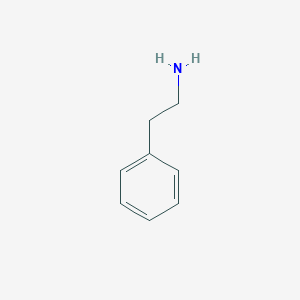| General Information of MET (ID: META00873) |
| Name |
Phenylethylamine
|
| Synonyms |
Click to Show/Hide Synonyms of This Metabolite
(2-Aminoethyl)benzene; (2-Aminoethyl)polystyrene; 1-Amino-2-phenylethane; 1-Phenethylamine; 1-Phenyl-2-amino-athan; 1-Phenyl-2-aminoethane; 1TNJ; 1Utm; 1Uto; 2-Amino-1-phenylethane; 2-Amino-fenylethan; 2-Fenylethylamin; 2-Phenethylamine; 2-Phenyl-ethanamine; 2-Phenylethanamine; 2-Phenylethanamine (acd/name 4.0); 2-Phenylethylamine; 2-Phenylethylamine (acd/name 4.0); 2-Phenylethylammonium chloride; Benzeneethanamine; Benzeneethanamine hydrochloride; Diphenethylamine sulfate; Omega-phenylethylamine; PEA; Phenethylamine; Phenethylamine conjugate acid; Phenethylamine hydrobromide; Phenethylamine hydrochloride; Phenethylamine mesylate; Phenethylamine perchlorate; Phenethylamine sulfate; Phenethylamine sulfate (2:1); Phenethylamine tosylate; Phenethylamine, 15N-labeled CPD; Phenethylamine, beta-(14)C-labeled CPD; Phenethylamine, monolithium salt; Polystyrene a-NH2; b-Phenylaethylamin; beta Phenethylamine; beta-Aminoethylbenzene; beta-Phenethylamine; beta-Phenylaethylamin; beta-Phenylethylamine
|
| Source |
Endogenous;Escherichia Coli Metabolite;Yeast Metabolite;Food additives;TCM Ingredients;Microbial
|
| Structure Type |
Phenethylamines (Click to Show/Hide the Complete Structure Type Hierarchy)
Benzenoids
Benzene and substituted derivatives
Phenethylamines
|
| PubChem CID |
|
| HMDB ID |
|
| Formula |
C8H11N
|
| Structure |
<iframe style="width: 300px; height: 300px;" frameborder="0" src="https://embed.molview.org/v1/?mode=balls&cid=1001"></iframe>
|
 |
|
3D MOL
|
2D MOL
|
|
Click to Show/Hide the Molecular/Functional Data (External Links/Property/Function) of This Metabolite
|
| KEGG ID |
|
| DrugBank ID |
|
| ChEBI ID |
|
| FooDB ID |
|
| ChemSpider ID |
|
| Physicochemical Properties |
Molecular Weight |
121.18 |
Topological Polar Surface Area |
26 |
| XlogP |
1.4 |
Complexity |
65 |
| Heavy Atom Count |
9 |
Rotatable Bond Count |
2 |
| Hydrogen Bond Donor Count |
1 |
Hydrogen Bond Acceptor Count |
1 |
| Function |
Phenethylamine (PEA) is an aromatic amine, which is a colorless liquid at room temperature. It is soluble in water, ethanol, and ether. Similar to other low-molecular-weight amines, it has a fishy odor. Upon exposure to air, it forms a solid carbonate salt with carbon dioxide. Phenethylamine is strongly basic and forms a stable crystalline hydrochloride salt with a melting point of 217 oC. Phenethylamine is also a skin irritant and possible sensitizer. Phenethylamine also has a constitutional isomer (+)-phenylethylamine (1-phenylethylamine), which has two stereoisomers: (R)-(+)-1-phenylethylamine and (S)-(-)-1-phenylethylamine. In the human brain, 2-phenethylamine is believed to function as a neuromodulator or neurotransmitter (a trace amine). Phenethylamine can be biosynthesized from the amino acid phenylalanine by enzymatic decarboxylation. It is also found in many foods such as chocolate, especially after microbial fermentation. However trace amounts from food are quickly metabolized by the enzyme MAO-B (into phenylacetic acid), preventing significant concentrations from reaching the brain. Phenylethylamine is a precursor to the neurotransmitter phenylethanolamine. High levels of PEA have been found in the urine of schizophrenics but it is not significantly elevated in the serum or CSF of schizophrenics. Urinary levels of PEA are significantly lower in children with attention deficit hyperactivity disorder (ADHD). It has been found that PEA is the primary compound found in carnivore (especially cat) urine that leads to rodent (mouse and rat) avoidance. In other words, phenylethylamine is useful for scaring off rodent pests. Quantitative HPLC analysis across 38 mammalian species has shown that PEA production in urine is especially enhanced in carnivores, with some producing >3,000-fold more than herbivores. Phenethylamine has been found to be a metabolite of Bacillus, Enterococcus and Lactobacillus.
|
|
Regulatory Network
|
|
|
|
|
|
|
|
|
 click to show the details of this protein
click to show the details of this protein
 click to show the details of experiment for validating this pair
click to show the details of experiment for validating this pair
 click to show the details of this protein
click to show the details of this protein
 click to show the details of experiment for validating this pair
click to show the details of experiment for validating this pair

